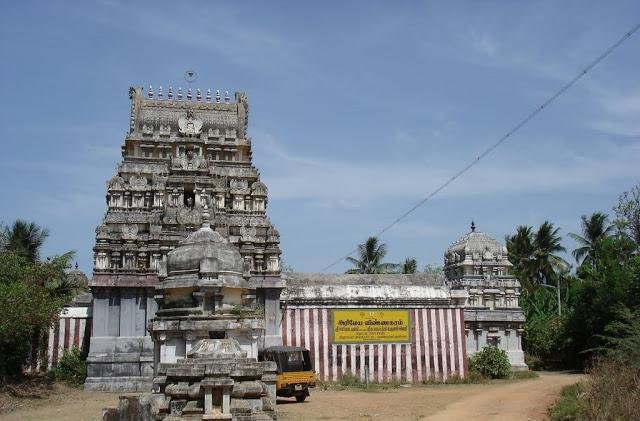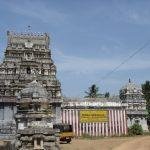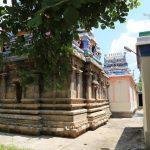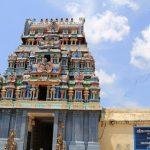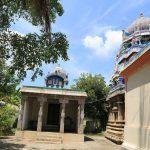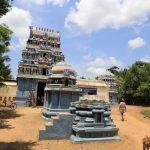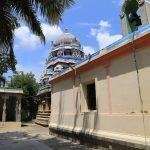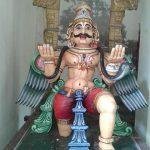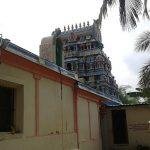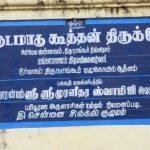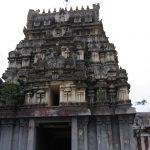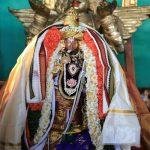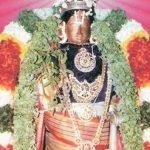Contents
Thiruarimeya Vinnagaram Kudamudakoothan Perumal Temple, Thirunangur, Nagapattinam
| Date built: | – |
|---|---|
| Deity: | Thiruarimeya Vinnagaram Kudamudakoothan Perumal |
| Architectural style: | Dravidian architecture |
| Major festivals | – |
| Locale: | Thirunangur |
| District:: | Nagapattinam |
| Address: | Sri Kudamadu Koothan Temple,Ariyameya Vinnagaram, Tirunangoor-609 106Nagapattinam District |
| Phone | +91- 4364 – 275 689 / +91- 94439 – 85843. |
It is one among the eleven divyadesams of Thirunangur Tirupathis and is closely associated with Thirumangai Alvar. The temple is open from 8 a.m. to 10 a.m. and 5 p.m. to 7 p.m and has four daily rituals at various times of the day. The Thirumangai Azhwar Mangalasasana Utsavam celebrated annually during the Tamil month of Thai is the major festival of the temple during which the festival images of the eleven Thirunangur Tirupathis are brought on mount designed like Garuda, called Garuda Vahana, to Thirunangur.
Temple Opening Time
The temple is open from 9.00 a.m. to 12.00 a.m. and from 4.00 p.m. to 6.00 p.m.
Prayers
Devotees pray for prosperous life, for relief from enemies and debt burdens. Devotees perform Thailakappu abishek to Lord.
Festivals
The temple is open from 8 a.m. to 10 a.m. and 5 p.m. to 7 p.m. The temple priests perform the pooja (rituals) during festivals and on a daily basis. As at other Vishnu temples of Tamilnadu, the priests belong to the Vaishnavaite community, a Brahmin sub-caste. The temple rituals are performed four times a day: Ushathkalam at 8 a.m., Kalasanthi at 10:00 a.m., Sayarakshai at 5:00 p.m. and Ardha Jamam at 7:00 p.m. Each ritual has three steps: Alangaram (decoration), neivethanam (food offering) and deepa aradanai (waving of lamps) for both Kudamudakoothan & his consort Amirtagadavalli.
During the worship, religious instructions in the Vedas (sacred text) are recited by priests, and worshippers prostrate themselves in front of the temple mast. There are weekly, monthly and fortnightly rituals performed in the temple. During the new moon day of the Tamil month Thai, the festival deity of Thirumangai Azhwar is brought to the temple from Thiruvali-Thirunagari.
The Thirumangai Azhwar Mangalasasana Utsavam is celebrated in the Tamil month of Thai (January–February). The highlight of the festival is Garuda Sevai, an event in which the festival images of the eleven Thirunangur Tirupathis are brought on mount designed like Garuda, called Garuda Vahana, to Thirunangur. The festive image of Thirumangai Azhwar is also brought on a Hamsa Vahanam (palanquin) and his paasurams (verses) dedicated to each of these eleven temples are recited during the occasion.
The festival images of Thirumangai Alvar and his consort Kumudhavalli Naachiyar are taken in a palanquin to each of the eleven temples. The verses dedicated to each of the eleven temples are chanted in the respective shrines. This is one of the most important festivals in the region which draws thousands of visitors. Vaikasi Visakam in May-June is another famous festival celebrated in this temple.
Pooja Timings
- Ushathkalam Pooja – 8 a.m.
- Kalasanthi Pooja – 10:00 a.m.
- Sayarakshai Pooja – 5:00 p.m.
- Ardha Jamam Pooja – 7:00 p.m.
Architecture
Legend / Local stories
Vishnu appearing in eleven forms on Shiva request:
The legends of all the eleven temples of Thirunangur are closely associated with each other. As per legend, the Hindu god Shiva started dancing in fury at this place after the death of his consort Uma due to the yagna (sacrifice) of Daksha. Each time his lock of hair touched the ground; there were eleven other forms of Shiva who appeared. The celestial deities were worried that if the dance continues, it would result in decimation of entire creations. They prayed to Vishnu for help, who appeared at this place.
On seeing Vishnu, Shiva’s anger was reduced and he requested Vishnu to appear in eleven forms like he did. On his request, Vishnu appeared in eleven different forms at Thirunangur. Arimeya Vinnagaram literally translates to the place where Hari (another name of Vishnu) resides.
The eleven places where Vishnu appeared are believed to be where the eleven temples in Thirunangur are located. They are;
| Thirukavalampadi | Gopalakrishnan along with Rukmini and Satyabama. |
| Thiruvannpurushothamam | Purushothaman along with Purushothama Naayaki. |
| Thiru Sempon Sei Kovil | Perarulalan along with Allimaamalar Naachiyar. |
| Thiru Devanar Thogai | Deiva Naayagan along with Kadal Magal Naachiyar. |
| Thiru Mani Koodam | Varadharaja Perumal along with Thirumagal Naachiyar and Bhoomi Piratti. |
| Thiru Paarthanpalli | Thamarai Kelvan along with Thamarai Naayaki, in standing posture in all the above Kshetrams. |
| Thirumanimaada Kovil | Narayana Gyana Nandha Vilaku along with Pundarigavalli. |
| Thiruvaali Thirunagari | Amrudhavalli Vedharajan, Narashimar along with Amrudha Kada valli. |
| Thiru Vaigunda Vinnagaram | Vaigunda Nadhan along with Periya Piratti. |
| Arimeya Vinnagaram | Kudamaadu Koothan along with Amrudha Kada valli, in sitting posture in above 4 Kshetrams. |
| Thirutheythri Ambalam | Shenkann Maal along with Sengamalavalli, in sleeping posture of the type Bhujanga Sayanam. |
Govardhana descended here on request of Shiva:
There is another local legend that Govardhana (Vishnu) descended here at the request of Shiva.
Arimeya Vinnagaram:
This place was selected by Perumal (Hari) Himself to reside and that’s the reason for the name of the place. Also, “Ari” means one who makes the sins to vanish. As the Lord of this place vanishes our sins, this place is called as Arimeya Vinnagaram.
Kuda Maadu Koothan:
Lord Shiva is well known for His dances. Lord Vishnu too demonstrates here as a good dancer by performing the “Kuda Koothu” dance and got His name as Kuda Maadu Koothan. Kuda Koothu is one type of Koothu (dance) in which the hero stands still and bring out expression as a light kept inside a pot. Lord Krishna performed this Koothu here to explain his Aadhi Moola Naraya Thathuvam i.e., the reason behind the birth of everything in this world.
Sage Uthanga arrival to Thiru Arimeya Vinnagaram:
Uthanga Maharishi got married to Prabhai and once a Crocodile took her away when both were taking holy bath in river Ganges. Uthanga Maharishi got vexed and roamed in many places and finally came to Thiru Arimeya Vinnagaram. Here Kuda Maadu Koothan gave Dharsan as Krishna to him and said that his wife has attained Mukthi (eternity) and thus got him out of his sorrow.
Vishnu made Uthanga to realize his mistake:
Sage Uthanga was a great devotee of the Supreme Lord and a learned brahmana. He was called Vipra Rishi. Vipra Rishis are very learned and wise Vedic scholars and are mostly brahmanas. There is an interesting pastime of Uthanga Rishi, which is elaborately described in the Vayu Purana. Sage Uthanga was a very pious, who performed penance for the welfare of mankind. He was a regular visitor to Dwaraka and Krishna was very dear to him. Krishna had a special affection towards him. After all Krishna is gau brahmana hita, the protector of the cows and brahmanas. In those times, brahmanas were very pious and strict in executing their duties.
Sage Uthanga used to wander in secluded areas and had no fixed residence. He was an avadhuta and stitapragnya. He had no desire, no lust, no hatred, and no greed. He was absorbed and fixed in another realm- pure devotional service of Krishna. Lord Krishna was very happy with the sage’s penances and prayers. He showed the sage His universal form or virata rupa and granted him any boon. Sage Uthanga told Krishna that he desired to see the universal form of the Lord and he just prayed to Krishna with trembling hands; he had no interest in petty material boons. But Lord Krishna insisted that the sage ask for some boon to be granted to him as a reward for his penance. As Lord Krishna insisted, the latter asked for a boon that whenever he was in need of water and whenever he felt thirsty, water may be provided to him.
Lord Krishna granted him the boon and disappeared. Sage Uthanga knew that in Bhagavad- Gita Krishna says, “I am the taste of water.” In short, Sage Uthanga asked for Krishna Himself. For pure devotees, everything is connected with Krishna. One day, after Sage Uthanga walked for a long distance in the desert area, he felt thirsty, but there was no trace of water. Then he remembered that Lord Krishna had granted him a boon that he would find water. As the sage recalled this, he saw a hunter dressed in torn rags accompanied by furious dogs, carrying water in a leather pouch. The hunter asked him, “Oh sage, would you like to drink some water?” Looking at the apparent condition of the hunter and being a staunch brahmana, the sage felt repelled. He politely refused.
The hunter again approached him to drink the water, but in utter disgust and anger the sage told the hunter to go way and that he was not interested in the water. The hunter and the dogs disappeared. Witnessing this, the sage realized that the hunter may have been Krishna Himself in disguise, come to quench the sage’s thirst. He felt hurt at how Lord Krishna had sent water to him through a chandala. How could He expect a brahmana to accept and drink water from the leather pouch?
Meantime, Lord Krishna appeared, smiled and asked him, “Who was the chandala?” Krishna had asked Indra deva to fetch the water. But instead of water, Indra had actually brought nectar that makes one immortal, but only on condition that one can see the Divinity in all. Sage Uthanga understood the meaning of it and begged pardon. He insisted that he did not desire for immortality and would only be interested in serving Lord Krishna as long as he lived.
Lord Vishnu gave darshan to Sage Uthanga:
Legend has it that Sage Uthanga learned the Vedas during his childhood from Sage Vaidhya. It was a practice that when a student left the hermitage of his guru after completing his studies, he would make some dakshina or offering to the lotus feet of the guru. Thus the child Uthanga asked his guru what he would like to have as guru dakshina, as it would be wise to offer what the teacher wanted than to offer what the student wanted. The guru Patni (guru’s wife) expressed her desire to have the earrings of the queen whose husband ruled that city. Uthanga approached the Queen with his request to have her earrings to offer as guru dakshina. Kings always fulfilled the desires of the brahmanas. So the Queen offered him the earrings without any hesitation; she had already heard about Uthanga’s truthfulness.
Uthanga happily returned to the hermitage of the guru. On his way back he was fatigued with hunger and thirst, so he decided to rest for a while. Immediately there appeared an attractive cowherd with a mud pot on his head and a bamboo stick in his hand, dancing to his own tunes, surrounded by his cows. Uthanga solemnly requested the cowherd to give him something to drink from his pot. The cowherd mischievously answered that the pot contained cow dung and urine that was accepted by his guru Vaidhya. Since it is very difficult to get the mahaprasadam of the guru, as soon as Uthanga heard this, without any further thought, he immediately put down his belongings and accepted the contents of the pot.
Suddenly there appeared out of nowhere, a boy who cleverly seized Uthanga’s belongings and slithered off. Uthanga chased the boy, but the boy vanished into a hole in a tree trunk. Uthanga desperately requested the cowherd boy to help him get back his belongings. At once there arrived a man on his horse back. The cowherd boy suggested that Uthanga request the horseman for help and followed Uthanga. Uthanga anxiously approached the rider and explained the whole pathetic state of affairs. The man was deeply moved at by the story and promised to help the boy get back his belongings. He moved in front of the tree trunk hole and forced the horse to sneeze heavily.
Instead of air and mucus, fire and heat came out of the horse’s nose. The boy who was in hiding came out because of the unbearable heat. He returned the belongings of Uthanga and begged for forgiveness. Uthanga expressed his gratitude to the cowherd boy and the horseback rider. He happily returned to the hermitage of his guru. Uthanga narrated all the events to Sage Vaidhya. After listening to Uthanga, Sage Vaidhya replied that the cowherd boy was none other than Lord Vishnu, the horse was Lord Agni and the man on horseback was Lord Indra. They had all come to test Uthanga’s devotion towards his guru.
The cow dung and urine were the divine medicine which helped Uthanga to remain safe and sound. Thus Uthanga’s desire to have darshana of Lord Vishnu in the form of a cowherd boy, Gopala, grew more and more after listening to his guru Sage Vaidhyar. The most compassionate Lord gave darshana as Sri Kudamadukuthan (kudam-adu-kuthan) to Sage Uthanga on this sacred land. In Tamil kudam means pot, adu means play and kuthan means dance. The Supreme Lord playfully appeared as a dancing boy with pot, known and worshipped here as Kudamadukuthan Perumal. The place has since then been referred to as Harimeya Vinnagaram or the place where Hari danced.
Photo Gallery
How to Reach:
This temple is in the village of Thiru Nangur and called as Arimeya Vinnagaram. Arimeya Vinnagaram means where Hari (another name of Lord Vishnu) resides. It’s about 5 miles (8 kms) away from Sirkazhi. This place is generally known as Kuda maadu Koothar Kovil. It is one among the eleven divyadesams of Thirunangur Tirupathis.
By Road:
The place is 8 km far from Sirkali. Buses are available only at specific hours. The visitor may reach Sirkazhi – Annankoil. The temple is 2 km from here. There are buses from Mayavaram / Sirkazhi that goes past Thiru Nangur. Direct special buses are available only on special occasions. If you are going in car it is 20 kms from Mayavaram and 8 kms from Sirkazhi. The road leading to this village is narrow and you might miss the turning from the main road if you are not watchful.
Extensive network of roads connect it to Chennai, Madurai, Tiruchirappalli, Pondicherry, Thanjavur and all other major cities. Nagapattinam is located at a distance of about 330kms from Chennai by Road.
By Train:
Nagapattinam railway junction connects Thiruvarur in the west, Nagore in the north, Velankanni in the south and Karaikal in the east. There is a daily express train to Chennai via Mayiladuthurai and Ernakulam via Coimbatore and it connects all major cities. Nearest Railway Station is located at Sirkazhi.
By Air:
The nearest Airport is Tiruchirapalli Airport, located 145 km (90 miles) away from the town.
Contact Details
Sri Kudamadu Koothan Temple,
Ariyameya Vinnagaram,
Tirunangoor-609 106
Nagapattinam District
Phone: +91- 4364 – 275 689
Mobile: +91- 94439 – 85843.

